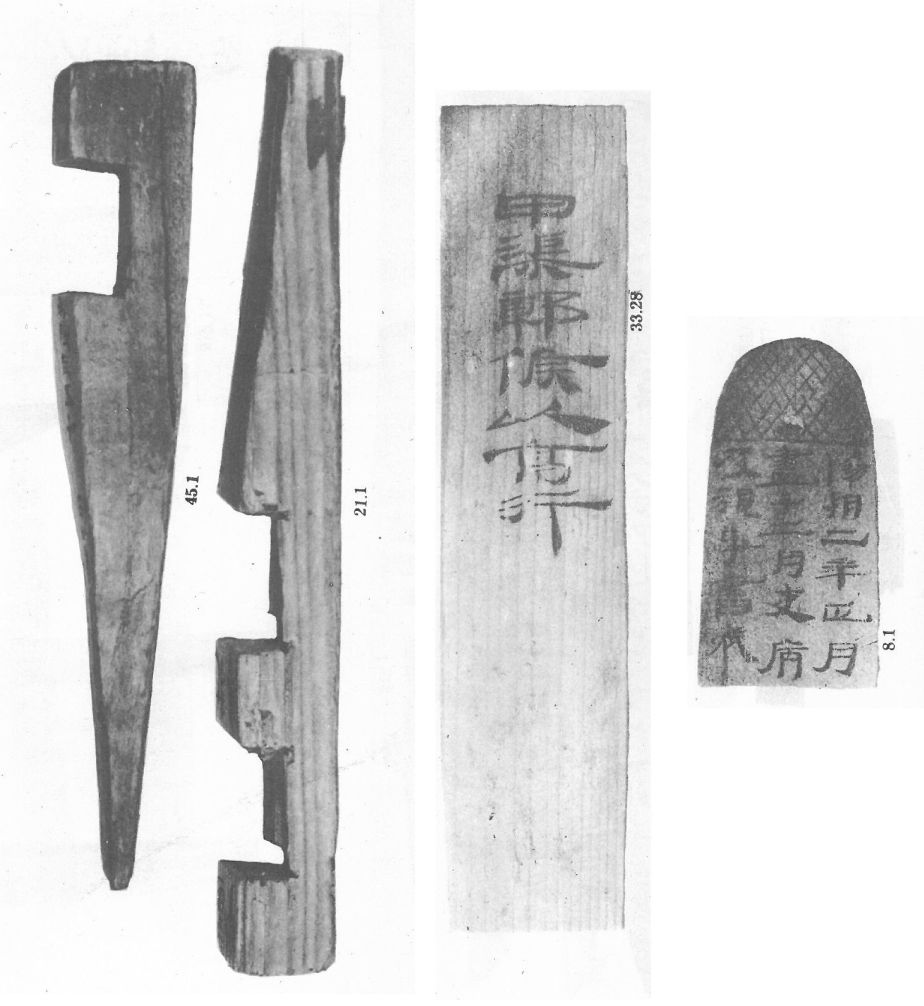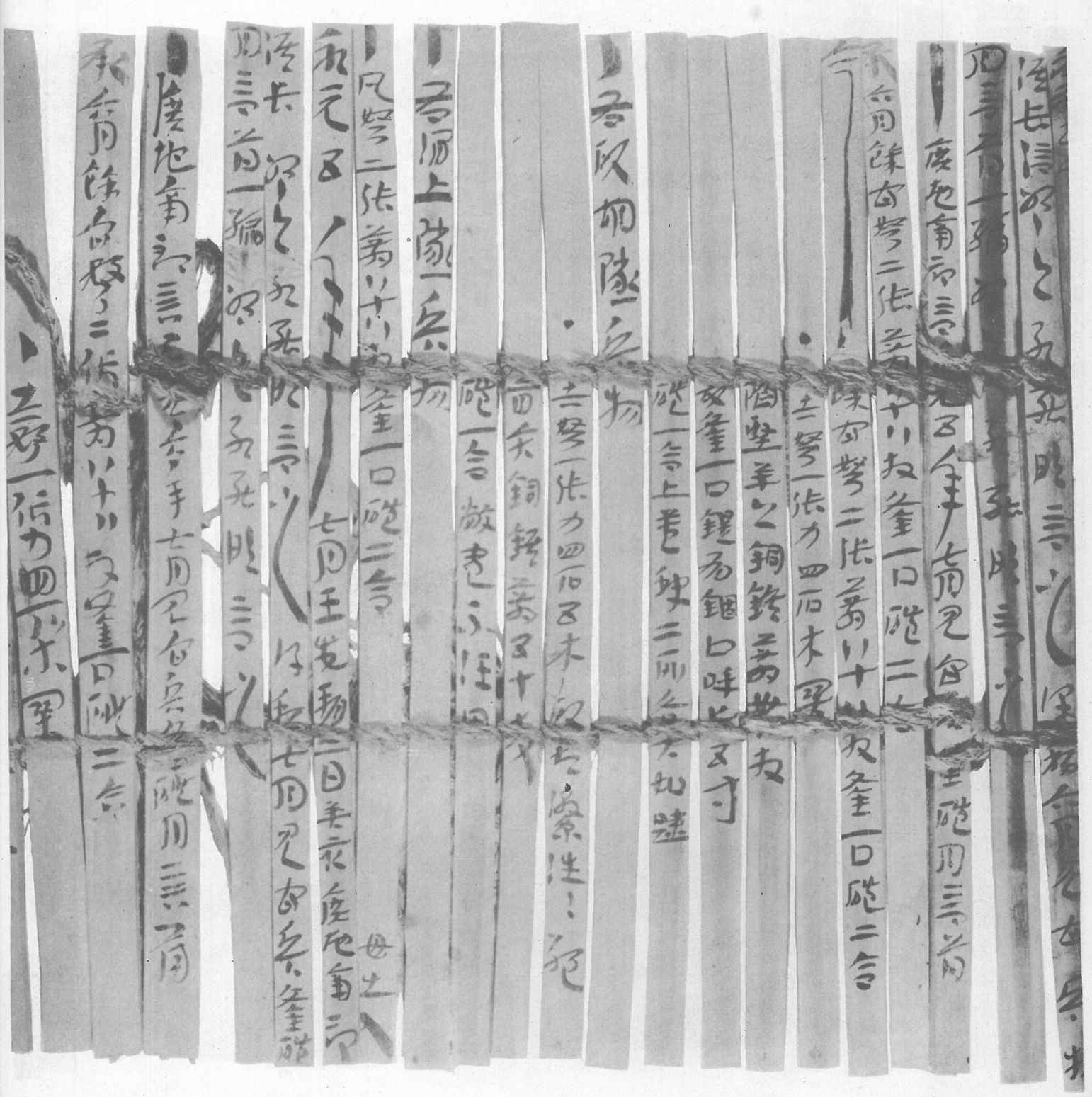The wooden slip texts of Juyan 居延 date from the Han period 漢 (206 BCE-220 CE) and were discovered in the ruins of ancient watchtower (fengsui 烽燧) posts of Juyan, and Juanshui 肩水, respectively, as well as other sites in the larger region. The former is located in what is today the Banner of Ejina 額濟納 in Inner Mongolia (Uyghurian name Qara Qoto, Chinese Heicheng 黑城), the latter in the district of Jinta 金塔, Gansu. The documents were compiled over a long period of time, ranging from the reign of Emperor Wu 漢武帝 (r. 141-87 BCE) to around 100 CE, with the majority dating from the mid-Western Han. All documents are subsumed under the name "Juyan texts".
The texts were written on about 30,000 pieces of wood of the desert poplar (Populus euphratica), Chinese white poplar (Populus tomentosa), the conifer Picea neoveitchii, Weeping willow (Salix babylonica), Chinese tamarisk (Tamarix chinensis), and salt cedar (Tamarix ramosissima). Only a small number is written on bamboo material. The Juyan documents are written on wooden slips (jian 簡), plates (du 牘), staves (gu 觚), tags (jie 楬) and documents closures (fengjian 封檢). The average length of the slips is 23 cm and most carry just one text column per slip, but there are also double-column slips.
 |
Left: Document closure (fengjian 封檢) with notches to tie threads and apply seals. Middle: Tag (jie 楬) with "delivery address" reading 甲渠鄣候以亭行 "To Zhang, commandant of Jiaqu, via the [seventh] post". Right: Tag used as title for a bunch of documents recording service activity, reading 陽朔二年正月/盡十二月吏病/及視事書卷 "Record of sickness and recovery of officers, including resumption of duties for the 1st to the 12th months of the second year of the reign-period Yangshuo". Lao 1957: 184, 493; Lao 1960: 73. Translation Cullen & Lo (2014). Concerning the postal service of Jiaqu, see Xu 2018. |
The documents were mainly written in chancery script (lishu 隸書), but there is also a substantial part written in "grass script" (zhang-caoshu 章草書). For this reason, the documents are studies by scholars of ancient Chinese script and of calligraphy. It seems that every post had scribes (yuanshi 掾史) who were responsible for documentation.
In 1930, a mixed Chinese-Swedish team (Zhong-Rui Xibei Kexue Kaocha Tuan 中瑞西北科學考察團) led by Sven Hedin (1865-1952) and Huang Wenbi 黃文弼 (1893-1966) carried out excavations in ten sites, namely Zongjian'ama 宗間阿瑪, Pochengzi 破城子 (yielding 4,422 slips), Wayintuoni 瓦因托尼, Bolansongzhi 博羅松治, Bukentuoni 布肯托尼, Chake'ertie 查科爾貼, Jinguan 金關, Diwan 地灣 (2,383 slips), and Dawan 大灣 (1334 slips). Small numbers of wooden slips were discovered in dozens of other sites in the region, yielding a total of 10,200 wooden slips. They are today owned by the Academia Sinica (Zhongyang Yanjiu Yuan 中央研究院) and called the "old Juyan texts" (Juyan jiujian 居延舊簡).
The "old texts" were screened, sorted, photographed and transcribed (by Lao Gan 勞幹, 1907-2003) by a team under the supervision of Ma Heng 馬衡 (1881-1955), Director of the Palace Museum (Gugong Buwuyuan 故宮博物院). The transcription was published in 1943/44 as a lithographic print. A letterpress print of it appeared in 1949. Reproductions of photographs only appeared in 1957 in Taiwan. The first widespread mainland publication, Juyan Hanjian jiabian居延漢簡甲編, was published in 1959 by the Science Press (Kexue Chubanshe 科學出版社). It constituted the first part of a set that was completed only in 1980 with the title Juyan Hanjian jia-yi bian 居延漢簡甲乙編, published by the Zhonghua Book Company 中華書局.
This collection includes also documents from a second excavation campaign carried out between 1972 and 1976, organised by the Juyan Archaeological Team, Gansu (Gansu Juyan kaogudui 甘肅居延考古隊, Gansu Sheng Wenwu Kaogu Yanjiusuo 甘肅省文物考古研究所), and yielded 7,865 slips from Pochengzi, 195 from the watchtower Jiaqu 4 甲渠第四, and 11,577 from Jinguan. These are today stored in the Provincial Museum of Gansu (Gansu Sheng Bowuguan 甘肅省博物館) and called the "new Juyan texts" (Juyan xinjian 居延新簡).
 |
 |
Excerpt from the inventory Yongyuan qiwu bu 永元器物簿. Top: Foto of the original, bottom: Transcription. The texts deals mainly with the number or arblasts, bolts, kettles and armoury. Lao 1957: 571; Lao 1960: 190. |
During the Han period, the region belonged to the commandery of Zhangyi 張掖 and was administrated military by the two commandants (duwei 都尉) of Juyan and Jianshui, each of which had the jurisdiction over several posts captains (houguan 候官).
The larger part of Juyan texts are archival documents from military border garrisons of the northwestern region of the Han empire. A smaller part consists of public documents, chronicles and private correspondence. The earliest datable documents was written in 90 BCE. The amount of documents found in individual watchposts is usually not large, and the quality differes from place to place. If the site was the bureau of an officer, more documents are found, with a wider array of textual content. Such texts consist of registers of ledgers (buce 簿冊) on the one hand, and of official documents (wenshu 文書) and private correspondence (xinzha 信札) on the other.
Registers include the names of soldiers, their pay (in grain), family members and allowances for them, statute labour to be delivered, rewards or penalties for performance at the autumn archery contests, even records of daily performance in labour tasks (zuobu 作簿, rijibu 日跡簿), and of the condition of the soldiers (zhe-shang bing bu 折傷兵簿, shuzu bei bu 戍卒被簿). They further include delivery tags for official communication (youshu ke 郵書課), records of inventory (shouyu qi bu 守御器簿, bingqi pu 兵器簿), (courier) horses and their equipment, ledgers of income and expenditure of monetary and non-monetary means (churu bu 出入簿, shibu 食簿), horses and chariots (chema bu 車馬簿) records of performance in individual posts (zhiguan bu 詣官簿), as well as registers at passes (dengji bu 登記簿).
The most perfectly conserved register documents is the inventory Yongyuan qiwu bu 永元器物簿, a 91 cm-long roll of wooden slips still tied together by threads.
Official documents were represented by imperial instructions (zhaoshu 詔書), military orders (xishu 檄書, shuxi 書檄), reports to superiors (dieshu 牒書), legal (lüling 律令, pinyue 品約, qiyue 契約) or jurisdictional texs (hezhuang 劫狀, yuanshu 爰書, xingsong 刑訟), passes of authority like tallies (fuquan 符券, guosuo 過所, fuchuan 符傳) and document closures (fengjian).
For each of these documentary types, a certain pattern of records seems to have existed, as can be seen in the strict arrangement of the part of the jurisdictional text Hou Lijun suo ze kou en shi 候粟君所責寇恩事, the regular report collections or answers submitted to superior institutions, or orders, commands and announcements to subordinated persons.
A small number of documents has nothing to do with the daily administration of the border garrisons, but highlights aspects of daily life. Such are almanachs (lipu 曆譜), texts of lesser learning (xiaoxue 小學) like Cangjiepian 倉頡篇 and Jijiupian 急就篇 or writing exercises, arithmetic tables (jiujiushu 九九術), quotations from classical texts like the "Confucian Analects" Lunyu 論語, or medical treatises (yiyaofang 醫藥方) and mantic texts (shushu 術數). Quite noteworthy is a text on the assessment of swords (Xiang lishan jiandao 相利善劍刀).